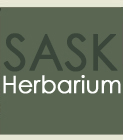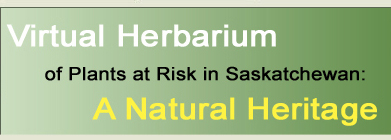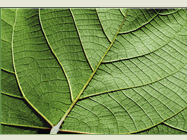|
| Erigeron hyssopifolius
Michx. |
|
| |
| TAXONOMY |
| |
| Family: |
Asteraceae or Compositae |
| Genus: |
Erigeron |
| |
| Species Synonyms: |
none |
| Common Names: |
hyssopleaf fleabane |
| |
| DISTRIBUTION |
| |
| Canada: |
Yukon Territory – Mackenzie District, Northwest
Territories – Keewatin District, Nunavut, to Newfoundland, south to
northeastern Alberta – central Saskatchewan – Ontario –
Nova Scotia |
| Saskatchewan: |
northern and central Saskatchewan |
| Ecoregion: |
Boreal Transition, Mid-Boreal Upland, Mid-Boreal
Lowland, Churchill River Upland, Athabasca Plain, Selwyn Lake Upland |
| |
| HABITAT |
| |
| Saskatchewan: |
wet soil in bogs, muskegs, and fens |
| Associated Species: |
black spruce, jack pine, sedge, shrubby cinquefoil,
sticky tofieldia, tamarack, white spruce |
| |
| RARITY STATUS |
| |
Provincial
Status According
to Harms (2003): |
Threatened |
| Nature Conservancy
Status: |
G5 S2 |
Saskatchewan
Species at
Risk Status: |
None |
| COSEWIC Status:
|
None |
| |
| Hyssopleaf fleabane
occurs in two or three general regions in Saskatchewan. Populations vary
in size. No immediate threats are known or anticipated for this species. |
| |
| SPECIES
DESCRIPTION |
| |
| Height: |
15 – 35 cm tall |
| Roots: |
fibrous; rhizome branched |
| Stems: |
tufted from woody crown or solitary, slender,
1 – 1.5 mm thick, dark-coloured, hairless or sparsely hairy |
| Leaves: |
no basal cluster, stem leaves only, alternate,
sessile, leaves largest and crowded at the middle, leaves longer than portion
of the stem between the leaves, often with shoots in the leaf axils of higher
leaves, 1 – 3 cm long, 2 – 3 mm wide, narrowly inversely lance-shaped,
tip tapered abruptly, hairless or sparsely hairy, margins entire to lined
with hairs |
| Inflorescence: |
heads 2 – many, < 1.5 cm in diameter,
stalk slender, naked or with 1 – 2 bracts; bracts 4 – 6 mm high,
thin, gradually tapered, generally hairless, occasionally a few sticky hairs |
| Flowers: |
ray flowers 20 - 50, 4 – 8 mm long, 0.4
– 1.4 mm wide, purple or white; no rayless female flowers present
between ray and disc flowers; disc flowers perfect, petals slender |
| Fruits: |
pappus single, bristles capillary |
| |
| ERIGERON
SPECIES FOUND IN SASKATCHEWAN |
| |
| 1 Leaves dissected |
E. compositus |
| 1 Leaves not dissected |
2 |
| |
|
2 Rays absent or inconspicuous (<
6 mm, if greater than 6 mm long, < 1 mm wide)
|
3 |
| 2 Rays present (> 6 mm) |
9 |
| |
|
| 3 Bracts hairless |
Conyza canadensis var. canadensis |
| 3 Bracts hairy and/or glandular |
4 |
| |
|
| 4 Bracts glandular, may be sparsely
hairy |
5 |
| 4 Bracts pubescent, but not glandular |
6 |
| |
|
| 5 Several to many heads; densely glandular
bracts |
E. acris ssp. politus |
| 5 Head solitary; somewhat glandular
bracts |
E. acris ssp. debilis |
| |
|
| 6 Pappus double |
7 |
| 6 Pappus single |
8 |
| |
|
| 7 Bract hairs flattened, stem hairs
appressed |
E. strigosus var. septentrionalis |
| 7 Bract hairs rounded, stem hairs
appressed to ascending |
E. strigosus var. strigosis |
| |
|
| 8 Leaves shorter than stalks of flower
heads; inflorescence branched, occasionally solitary; rayless female flowers
present between ray and disc flowers |
E. elatus |
| 8 Leaves sometimes exceeding lower
heads in inflorescence; inflorescence unbranched; occasionally solitary;
rayless female flowers absent |
E. lonchophyllos |
| |
|
| 9 Plants < 20 cm high; heads few
to solitary |
10 |
| 9 Plants > 20 cm high; heads 2
– many |
12 |
| |
|
| 10 Leaves usually basal only; flowers
white |
E. radicatus |
| 10 Stem leaves present; flowers yellow
to white or purple |
11 |
| |
|
| 11 Leaves 3 – 7 cm long, with
1 – 3 stem leaves; flowers yellow to white or lavender |
E. ochroleucus var. scribneri |
| 11 Leaves 1 – 3 cm long, many
stem leaves; flowers purple or white |
E. hyssopifolius |
| |
|
| 12 Stems without leaves or with bract-like
leaves |
E. pumilus |
| 12 Stems distinctly leafy, often reduced
upwards |
13 |
| |
|
| 13 Ray florets coloured |
14 |
| 13 Ray flowers white |
16 |
| |
|
| 14 Stem leaves largest at the middle
of stem |
E. hyssopifolius |
| 14 Stem leaves reduced upwards |
15 |
| |
|
| 15 Leaves clasping and with ear-like
lobes |
E. philadelphicus var. philadelphicus |
| 15 Leaves not clasping or with ear-like
lobes |
E. glabellus var. glabellus |
| |
|
| 16 Stem leaves largest at the middle
of stem |
E. hyssopifolius |
| 16 Stem leaves reduced upwards |
17 |
| |
|
| 17 Perennial with woody persistent
base of stem, tough rhizome, or thick taproot |
18 |
| 17 With neither deep-well developed
rhizomes nor woody stem bases, at most a short rhizome or stolons |
19 |
| |
|
| 18 Persistent woody base of stem;
stem leaves 5 – 7 |
E. glabellus var. glabellus |
| 18 Thick taproot; stem leaves >
10 |
E. caespitosus |
| |
|
| 19 Pappus of ray and disc florets
unlike (pappus of rays single) |
E. annuus |
| 19 Pappus of ray and disc florets
alike |
E. asper |
|






